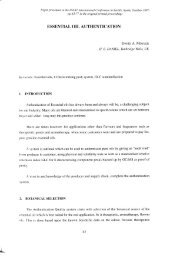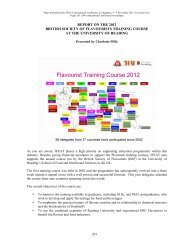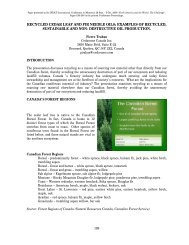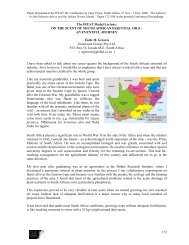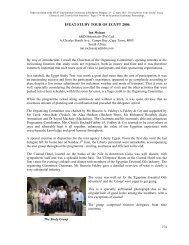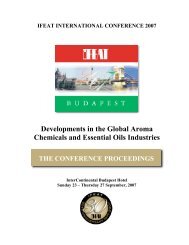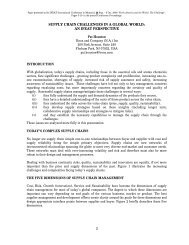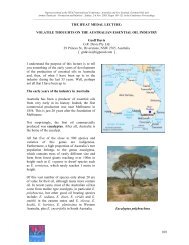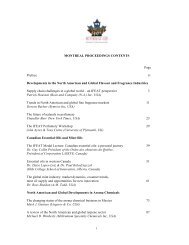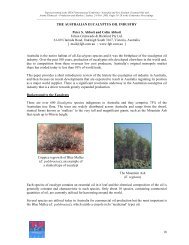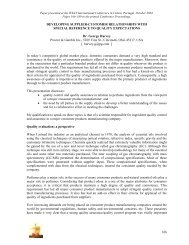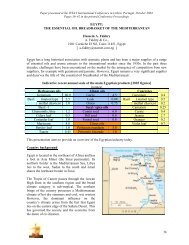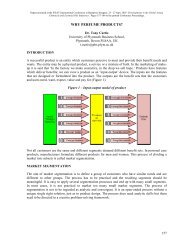Paper presented at the IFEAT Int. Conference in Cape Town
Paper presented at the IFEAT Int. Conference in Cape Town
Paper presented at the IFEAT Int. Conference in Cape Town
Create successful ePaper yourself
Turn your PDF publications into a flip-book with our unique Google optimized e-Paper software.
Species identity <strong>in</strong> plant<strong>at</strong>ionsBecause veget<strong>at</strong>ive propag<strong>at</strong>ion wasnot developed until recently, all of<strong>the</strong> early buchu plant<strong>at</strong>ions wereestablished us<strong>in</strong>g <strong>in</strong>dividualseedl<strong>in</strong>gs and <strong>the</strong>re has often beengre<strong>at</strong> confusion regard<strong>in</strong>g geneticidentity of many plant<strong>at</strong>ions [6] .In particular, A. crenul<strong>at</strong>a and <strong>the</strong>hybrid A. betul<strong>in</strong>a x crenul<strong>at</strong>a plantsare practically identical, even beyond<strong>the</strong> seedl<strong>in</strong>g stage.To add to this confusion, <strong>the</strong> two phenotypically <strong>in</strong>dist<strong>in</strong>guishable chemotypes of A. betul<strong>in</strong>a (adiosphenol and an isomenthone chemotype), with drastically different essential oil compositions, areoften found mixed <strong>in</strong> plant<strong>at</strong>ions.These factors, toge<strong>the</strong>r with competitive behaviour of some oil distillers and <strong>the</strong> lack of sufficientanalytical facilities, have caused gre<strong>at</strong> confusion regard<strong>in</strong>g <strong>the</strong> production of <strong>the</strong> <strong>in</strong>dividual species andchemotypes of buchu oil. Many a farmer has ended up with a beautiful field of cultiv<strong>at</strong>ed A. crenul<strong>at</strong>aplant m<strong>at</strong>erial <strong>in</strong>stead of <strong>the</strong> more valuable A. betul<strong>in</strong>a th<strong>at</strong> he <strong>in</strong>tended to cultiv<strong>at</strong>e, ditto regard<strong>in</strong>g <strong>the</strong>chemotypes of A. betul<strong>in</strong>a.Fur<strong>the</strong>rmore, <strong>the</strong>se confusions have even filtered through to <strong>the</strong> oil market with <strong>the</strong> result th<strong>at</strong> eventoday some of <strong>the</strong> largest traditional users of buchu oil for flavour and fragrance applic<strong>at</strong>ions havespecific<strong>at</strong>ions for ‘Betul<strong>in</strong>a buchu oil’, which is <strong>in</strong> fact obta<strong>in</strong>ed from A. crenul<strong>at</strong>a, or worse a ‘secret’mixture of A. betul<strong>in</strong>a and A. crenul<strong>at</strong>a.The species buchu oil th<strong>at</strong> a client requires is sometimes not mentioned <strong>at</strong> all, thus putt<strong>in</strong>g <strong>the</strong> onus on<strong>the</strong> distiller to exhaustively m<strong>at</strong>ch a specific client’s specific<strong>at</strong>ion. Even when ‘Betul<strong>in</strong>a buchu oil’ isrequested, <strong>the</strong> chemotype is never known until a sample is approved. Clearly this situ<strong>at</strong>ion is not ideal.<strong>Int</strong>erest<strong>in</strong>gly, it is our experience th<strong>at</strong> very rarely are pure forms of ei<strong>the</strong>r chemotypes of A. betul<strong>in</strong>arequired.There is currently no ISO standard for buchu oil(s), and only general CAS and FEMA numbers (CAS:68650-46-4; FEMA: 2169) are assigned to ‘Buchu oil’, represent<strong>in</strong>g all <strong>the</strong> various types and speciesof buchu oil available.Essential oil chemistryModern gas-chrom<strong>at</strong>ographic analyses have made <strong>the</strong> identific<strong>at</strong>ion of <strong>the</strong> exact species / chemotypeof buchu plant m<strong>at</strong>erial a rout<strong>in</strong>e exercise.A. betul<strong>in</strong>a (both chemotypes), A. crenul<strong>at</strong>a and A. betul<strong>in</strong>a x crenul<strong>at</strong>a essential oils all conta<strong>in</strong>nearly <strong>the</strong> same chemical components, but <strong>in</strong> gre<strong>at</strong>ly vary<strong>in</strong>g amounts:• The ma<strong>in</strong> flavour contributors <strong>in</strong> buchu oils are <strong>the</strong> unique high-boil<strong>in</strong>g 8-mercapto-pmenthan-3-one(FEMA 3177) isomers and <strong>the</strong>ir acet<strong>at</strong>es, 8-acetylthio-p-menthan-3-one(FEMA 3809) [4,7,8] .101



